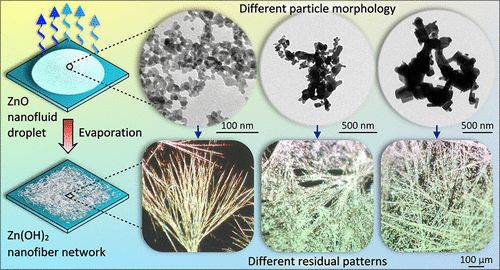Our official English website, www.x-mol.net, welcomes your feedback! (Note: you will need to create a separate account there.)
Hierarchical Surface Patterns upon Evaporation of a ZnO Nanofluid Droplet: Effect of Particle Morphology
Langmuir ( IF 3.9 ) Pub Date : 2018-01-17 00:00:00 , DOI: 10.1021/acs.langmuir.7b03854 Patryk Wąsik 1 , Christian Redeker 1 , Thomas G. Dane 2 , Annela M. Seddon , Hua Wu 1 , Wuge H. Briscoe 1
Langmuir ( IF 3.9 ) Pub Date : 2018-01-17 00:00:00 , DOI: 10.1021/acs.langmuir.7b03854 Patryk Wąsik 1 , Christian Redeker 1 , Thomas G. Dane 2 , Annela M. Seddon , Hua Wu 1 , Wuge H. Briscoe 1
Affiliation

|
Surface structures with tailored morphologies can be readily delivered by the evaporation-induced self-assembly process. It has been recently demonstrated that ZnO nanorods could undergo rapid chemical and morphological transformation into 3D complex structures of Zn(OH)2 nanofibers as a droplet of ZnO nanofluid dries on the substrate via a mechanism very different from that observed in the coffee ring effect. Here, we have investigated how the crystallinity and morphology of ZnO nanoparticles would affect the ultimate pattern formation. Three ZnO particles differing in size and shape were used, and their crystal structures were characterized by powder X-ray diffraction (XRD) and transmission electron microscopy (TEM). Their dispersions were prepared by sonication in a mixture of isobutylamine and cyclohexane. Residual surface patterns were created by drop casting a droplet of the nanofluid on a silicon substrate. The residual surface patterns were analyzed by scanning electron microscopy (SEM) and microfocus grazing incidence X-ray diffraction (μGIXRD). Nanofluid droplets of the in-house synthesized ZnO nanoparticles resulted in residual surface patterns consisting of Zn(OH)2 nanofibers. However, when commercially acquired ZnO powders composed of crystals with various shapes and sizes were used as the starting material, Zn(OH)2 fibers were found covered by ZnO crystal residues that did not fully undergo the dissolution and recrystallization process during evaporation. The difference in the solubility of ZnO nanoparticles was linked to the difference in their crystallinity, as assessed using the Scherrer equation analysis of their XRD Bragg peaks. Our results show that the morphology of the ultimate residual pattern from evaporation of ZnO nanofluids can be controlled by varying the crystallinity of the starting ZnO nanoparticles which affects the nanoparticle dissolution process during evaporation.
中文翻译:

ZnO纳米流体液滴蒸发后的分层表面图案:颗粒形态的影响
具有定制形态的表面结构可以通过蒸发诱导的自组装过程轻松交付。最近已经证明ZnO纳米棒可以经历快速的化学和形态转变为Zn(OH)2的3D复杂结构纳米纤维作为ZnO纳米流体的液滴通过一种与咖啡环效应中观察到的机制非常不同的机制在基板上干燥。在这里,我们研究了ZnO纳米颗粒的结晶度和形态如何影响最终图案的形成。使用了三种尺寸和形状不同的ZnO颗粒,并通过粉末X射线衍射(XRD)和透射电子显微镜(TEM)对它们的晶体结构进行了表征。通过在异丁胺和环己烷的混合物中超声处理来制备它们的分散体。通过在硅基板上滴铸纳米流体的液滴来创建残留的表面图案。通过扫描电子显微镜(SEM)和微焦点掠入射X射线衍射(μGIXRD)分析残留的表面图案。2根纳米纤维。然而,当使用由具有各种形状和尺寸的晶体组成的商业获得的ZnO粉末作为起始原料时,发现Zn(OH)2纤维被ZnO晶体残留物覆盖,该ZnO晶体残留物在蒸发过程中没有完全经历溶解和重结晶过程。ZnO纳米粒子的溶解度差异与其结晶度差异有关,这是通过对其XRD布拉格峰的Scherrer方程分析进行评估的。我们的结果表明,可以通过改变起始ZnO纳米颗粒的结晶度来控制ZnO纳米流体蒸发的最终残留图案的形态,这会影响纳米颗粒在蒸发过程中的溶解过程。
更新日期:2018-01-17
中文翻译:

ZnO纳米流体液滴蒸发后的分层表面图案:颗粒形态的影响
具有定制形态的表面结构可以通过蒸发诱导的自组装过程轻松交付。最近已经证明ZnO纳米棒可以经历快速的化学和形态转变为Zn(OH)2的3D复杂结构纳米纤维作为ZnO纳米流体的液滴通过一种与咖啡环效应中观察到的机制非常不同的机制在基板上干燥。在这里,我们研究了ZnO纳米颗粒的结晶度和形态如何影响最终图案的形成。使用了三种尺寸和形状不同的ZnO颗粒,并通过粉末X射线衍射(XRD)和透射电子显微镜(TEM)对它们的晶体结构进行了表征。通过在异丁胺和环己烷的混合物中超声处理来制备它们的分散体。通过在硅基板上滴铸纳米流体的液滴来创建残留的表面图案。通过扫描电子显微镜(SEM)和微焦点掠入射X射线衍射(μGIXRD)分析残留的表面图案。2根纳米纤维。然而,当使用由具有各种形状和尺寸的晶体组成的商业获得的ZnO粉末作为起始原料时,发现Zn(OH)2纤维被ZnO晶体残留物覆盖,该ZnO晶体残留物在蒸发过程中没有完全经历溶解和重结晶过程。ZnO纳米粒子的溶解度差异与其结晶度差异有关,这是通过对其XRD布拉格峰的Scherrer方程分析进行评估的。我们的结果表明,可以通过改变起始ZnO纳米颗粒的结晶度来控制ZnO纳米流体蒸发的最终残留图案的形态,这会影响纳米颗粒在蒸发过程中的溶解过程。



























 京公网安备 11010802027423号
京公网安备 11010802027423号